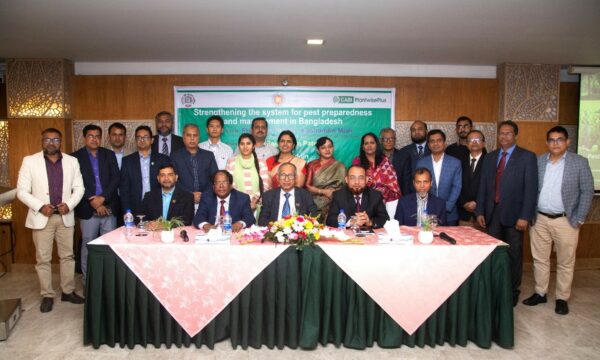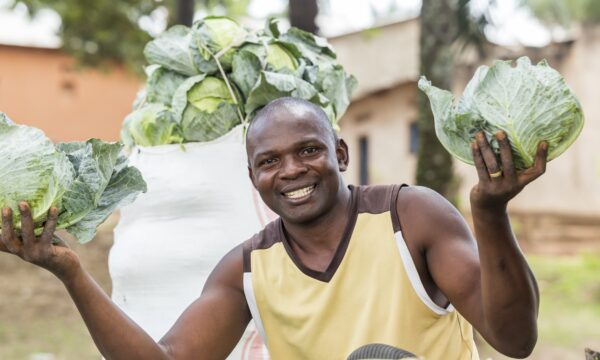
Even during the COVID lockdown, news channels buzzed in Bangladesh on the arrival of swarms of an unknown pest that were partially covering mango and guava crops, and some forest trees in Teknaf Upazila, Cox’s Bazar District.
The Ministry of Agriculture (MoA), Bangladesh, took immediate steps and the team from Department of Agricultural Extension (DAE), Bangladesh Agricultural Research Institute (BARI) and others from the National Agricultural Research System (NARS) rushed to the site to safely collect samples, in order to identify the pest and take up immediate steps for its management.
The Director General of DAE Dr. Md. Abdul Muyeed said that the pest was currently being managed with pesticides. Dr. Debasish Sarker, Head of the Division of Entomology from Bangladesh Agricultural Research Institute (BARI) also emphasised the urgent need to manage the pest as his scientists were in the field collecting samples for identification.
Professor Dr. Mohammad Shaef Ullah, Department of Entomology, Bangladesh Agricultural University, reported on social media that the insect was identified as Spotted coffee grasshopper and though it is not a new pest in Bangladesh, it had never previously been seen in such huge density that it overwhelmed farmers.
Spotted coffee grasshopper (Aularches miliaris) is a monotypic grasshopper species of the genus Aularches, belonging to the family Pyrgomorphidae. The bright warning colours keep away predators and their defence when disturbed includes the ejection of a toxic foam. The insect is known by a variety of names including, ghost grasshopper, northern spotted grasshopper, and foam grasshopper, and it even enjoys some popularity as a pet insect.

Photo provided by Debashish Sarker, BARI 
Photo provided by Zahirul Md., DAE
Across its host range, A. miliaris is a minor insect pest of around 30 crops including major crops in Bangladesh like coffee, coconut, mango, guava, rice, and pigeon pea, causing occasional economic damage to these and many other crops.
Although these grasshoppers are not a major pest, this outbreak could be due to i) ecological disruptions such as the effect of relatively prolonged hot weather allowing an increased number of generations per season; (ii) incessant and indiscriminate pesticide use affecting the natural enemies causing a phenomenon known as a ‘natural enemy ravine’; (iii) changes in the soil (where grasshoppers lay eggs) and crop practices or husbandry (e.g. dense crop canopy or density; pruning rounds) and (iv) any evidence of migration from other areas.
Plantwise in Bangladesh supported its partners, DAE, with help of an online workshop with Bangladesh Agricultural University and media experts to draft a Pest Management Decision Guide (PMDG) for the country. It includes simple preventive measures like destroying egg pods by digging the ground and crushing the egg pods to avoid the outbreaks by the pest. Also, botanicals like neem mixed with soap could be effective. The chemicals which are low in toxicity and registered in-country are recommended for the pest above threshold levels.
At this time of global pandemic and with many countries in lockdown, social media is an effective channel in Bangladesh to disseminate information. There are several Whatsapp groups with more than 3,000 members and Facebook pages which include not only extension officials but several farmers associations. Once the PMDG is ready, these communication channels will enable a wide reach to the farmers that need it most – particularly now when physical plant clinics are not operating.
Plantwise was launched in Bangladesh in 2015, find out more about its impact.
Author affiliations
Dr. Zahirul Haqe (DAE, Bangladesh)
Prof. Dr. Md. Shaef Ullah (Bangladesh Agricultural University)
Dr. Malvika Chaudhary (Plantwise, Regional Coordinator Asia)
Header image, farmers in Bangladesh ©CABI
1 Comment
Leave a Reply
Related News & Blogs
Common Papaya Disorders: A Comprehensive Guide
Papaya, also commonly known as the papaw or pawpaw, is a large tropical fruit-producing plant originating from Central America. Market demand for tropical fruits has steadily grown, and consequently, the papaya has become an important agricultural expo…
3 April 2024







[…] https://blog.plantwise.org/2020/05/13/spotted-coffee-grasshopper-in-bangladesh/ https://blog.plantwise.org/2020/06/25/lockdown-unlocking-technology-for-indias-farmers/ […]